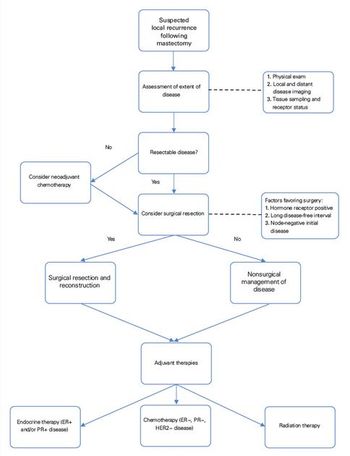
Breast reconstruction improves quality of life, but providers must be aware of the risks and benefits of each reconstruction approach in the setting of postmastectomy radiotherapy.

Your AI-Trained Oncology Knowledge Connection!


Breast reconstruction improves quality of life, but providers must be aware of the risks and benefits of each reconstruction approach in the setting of postmastectomy radiotherapy.

A chest wall recurrence of breast cancer following mastectomy is a complex clinical problem that can push centers to the limits of their resources.

To universally recommend breast irradiation for all women after excision of DCIS lesions ignores information now available to us that can spare the majority of women with DCIS the downsides of RT, but be applied in the treatment of DCIS patients at greater risk for invasive disease.

The DCIS Score provides clinically relevant information about personal risk that can guide patient discussions and facilitate shared decision making.

Kinder, gentler cancer therapy is neither of those things if it fails to be as effective in controlling the cancer. When an area of completely clinically regressed cancer is excised, there is commonly residual cancer present.

To make the punishment fit the crime, you would want the decision of whether or not to use adjuvants to be informed by the degree of risk that the DCIS would recur. What factors can predict for an increased risk of recurrence, or more importantly, the risk of an invasive breast cancer occurring?

While ONCOLOGY has continued to evolve along with the field of oncology-for example, it now addresses critical issues of science and socioeconomics-it has remained true to the founding principles. Perhaps largely for this reason, the journal continues to be widely read across the entire oncology community.

Since 1990, death rates from breast cancer have decreased, mainly in women younger than 50 years of age (3.3% per year) vs women aged 50 years or older (2% per year), reflecting the benefit of widespread use of systemic treatment added to early detection.[1]

The past twenty-five years have seen a drop in deaths from cancer, particularly in the last half of that period.

A recent study has provided evidence that the use of contralateral prophylactic mastectomy (CPM) is increasing

The recommended primary treatment approach for women with metastatic breast cancer and an intact primary tumor is the use of systemic therapy. Local therapy of the primary tumor is recommended only for palliation of symptoms. However, a series of retrospective studies examining practice patterns for this problem show that about half the women presenting with de novo metastatic disease undergo resection of the primary tumor, and suggest that women so treated survive longer than those who do not undergo resection of the intact primary. In analyses that adjust for tumor burden (number of metastatic sites), types of metastases (visceral, nonvisceral), and the use of systemic therapy, the hazard ratio for death is reduced by 40% to 50% in women receiving surgical treatment of the primary tumor. The benefit of surgical treatment appears to be confined to women whose tumors were resected with free margins. However, these results may simply reflect a selection bias (ie, younger, healthier women with a smaller tumor burden are more likely to receive surgical treatment). In addition, the role of other locoregional therapy such as axillary dissection and radiotherapy is not addressed in these studies. In view of these data, the role of local therapy in women with stage IV breast cancer needs to be reevaluated, and local therapy plus systemic therapy should be compared to systemic therapy alone in a randomized trial.

Women with any family history of breast cancer assume a high probabilityof risk. Counseling women involves ascertainment of an accuratefamily history and use of the best predictive models to assess boththe risk of a known mutation and the risk of breast cancer. This riskmust then be considered in the contexts of both the woman’s lifetimeand the next decade, in each instance carefully separating the risk ofdeveloping cancer from the risk of mortality. These two risks are oftenemotionally melded in women who have watched a loved one die ofcancer. The options for a woman at significantly increased risk of breastcancer include optimal surveillance, chemoprevention, and prophylacticsurgery. This entire field is in continuing evolution as better methodsof diagnosis, screening, and chemoprevention continue to enter clinicalpractice.

Published: January 1st 2004 | Updated:

Published: July 1st 2007 | Updated:

Published: August 15th 2013 | Updated:

Published: April 30th 2008 | Updated:

Published: April 30th 2011 | Updated:

Published: December 16th 2011 | Updated: